... or to quote Leonardo DiCaprio in the film Blood Diamond, "T.I.A. (This Is Africa)".

But first, a shout out to Laurie, one of the Aussies who went on my Capitol Hill tour. He has a travel blog "Where's My Laurie" of his round of the world journey, and his fresh writing stylings makes me smile. See if you can spot the reference to me.
And another to Mary for her tales of volunteering at an orphanage (yes orphanage) in Mongolia (yes Mongolia). Definitely a must read.
Anyways, back to Africa. This was our last 24 hours on the continent, and that made us both happy, but mostly sad. The above is indeed a picture of the airport at Kilimanjaro (KIA). That is also a picture of the entire length of the airport. Then again, they only have about half a dozen international flights a day, with the only major carriers I could ascertain being Air Tanzania, Kenya Airways, KLM, Ethiopian Airlines, and South African Airways.
Which brings me in a roundabout way to transportation, and specifically ground transportation. Or roads. The roads in Tanzania are surprisingly well-deserving of their own post, as a general reflection of the infrastructure of the country. They deserve their own post because, and maybe this is just because of my Western upbringing, but it is something that you think about, at least in the back of your mind, pretty much every second of your day.
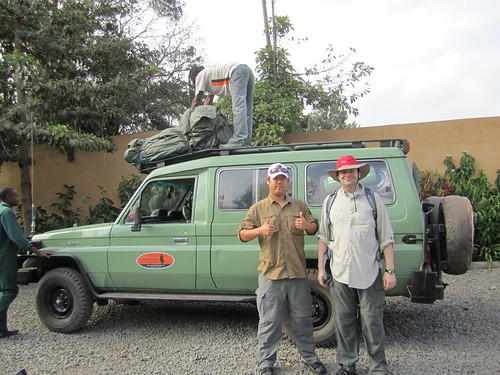
As I extensively noted in one of my earliest posts, we spent the better part of four days in this car. We should have named it in hindsight.
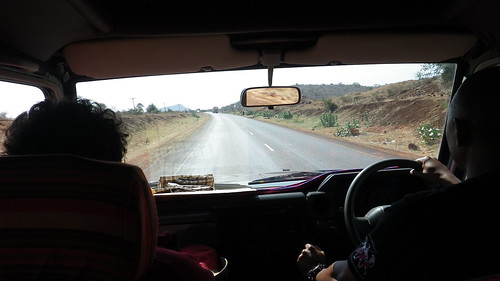
Anyways, this is a typical road in Tanzania. Looks pretty normal right? Well, you would be correct, except this is the second or third busiest highway in all of Tanzania. This would be the equivalent of an I-95 on the East Coast or "the 5" in California. Not only does this road connect three major cities containing several million people, but it also connects the airport, all the major safari areas, and the major agricultural zone around Kilimanjaro (mostly sugar canes and bananas).
My point in all this, is that the fact it has only two lanes is ABSOLUTELY RIDONKULOUS. Now, of course, Tanzania has less cars than a lot of countries, so that makes the problem slightly better. Nevertheless, however, it was immensely clear just an hour into our journey that no matter how you slice it, the roads are completely inadequate for the amount of traffic on them.
Let me give you some examples.

So, in Tanzania, they drive on the left, a bestige of British colonialism. As you can see in this picture, however, we are driving in the middle, and arguably to the right of the road. That is because we are passing that van in front of us. You see to the right of the van, however, that there is a man on a motorcycle. You would think it may be a problem that we are heading straight for this guy? You would be wrong.
You see, in Tanzania, motorcycles may as well just not exist, as drivers pay absolutely no heed to them as they drive. Are they in your lane? Drive past them close enough to touch them. But don't even think about veering from your line. Are they in the opposite lane? You're bigger and they will miss you. Yes, that is what our driver actually told us. To be fair, the motorcyclists didn't even miss a beat. They looked as calm and collected as if they were sitting at an intersection. And they were everywhere, which I guess was the least surprising thing of all.
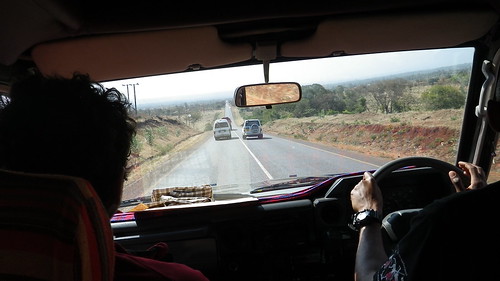
Now, on this "highway," the lane divider is very much a suggestion. I don't think we ever had a moment when some car wasn't passing some other car. I talked about the motorcycles, but drivers generally had little regard for any on-coming traffic, as cars and vans and trucks regularly missed head on collisions by a matter of inches at speeds approaching 100 kilometers an hour. So, they are either the greatest drivers in the world, or dumb. I guess it's a bit of both.
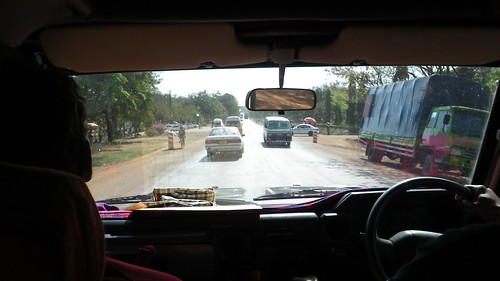
I took this picture for two reasons. One was to get a picture of the van. This is the public transportation system. Except it is not public. It is private. In fact, a lot of them are run by churches, which if you think about it, makes a lot of sense. (1) Churches have the resources to own a van and (2) they don't use it all-day every-day, so this is a way to make some extra money. You could tell those because they advertised their church instead of some product. Capitalist advertising at its best.
The way they work is very much like buses, and also not like buses. There are a couple of routes mostly centered on the "highway," and people will literally walk to the edge of the highway and flag one down. It's reaching the highway that is a pain. Once you get there, one will be by very quickly - these vans were literally everywhere. You then pay a fare, and get in. Seems simple right? Well, odds are, you will be sitting in someone's lap. Not just kids. Not just women. Not just small people. EVERYONE. Sometimes three deep one seat - kind of like Russian Matryoshka dolls. Needless to say, as you get closer to the cities, these vans are literally filled to the brim... a little too similar to clown cars for my tastes.
The second reason I took the picture was because the cars were slowing because of a speed bump - really a series of three speed bumps - on a freaking HIGHWAY. Granted these were in places where you would expect to find speed bumps - major population centers, markets, etc. - but still, it's on a HIGHWAY. And I also took a picture because of their name. They are called Dead Policemen by the locals. Shows the sort of respect people have for them. David says that things are getting better (his father is a policeman), but locals still don't trust them because they are so corrupt.
There is this story (I can't remember if David told us or it was in a guidebook I read) where a Westerner was riding a long distance bus when he was robbed (larcened?) by a local. He saw the guy do it, and yelled for him to stop. The locals quickly grabbed him (most people have pride in their country and hate this) and stopped the bus. The Westerner assumed they were just going to get the police, but instead they started him beating him literally to death. The Westerner asked one of the women why they didn't just get the police, and she said that the robber would just bribe them and he would be out the next day; that this was the only way to get true justice. Needless to say, the guy was horrified and went to pull people off of the robber. After enduring a few flails meant for the robber, he finally did get them to stop, but the irony was not lost on him that he was saving the life of the man who had robbed him. T.I.A.
I took the above video because about a mile of the highway was under construction while we were there. And since the highway was only two lanes wide, there was no way to just shut down one lane and work on the other. So, all traffic was merely diverted off the road into the dirt. And it was not smoothed over dirt, as you can see from the above video. In fact, I have no idea how motorcycles, or even small cars, got through this part. And it's not like there was a detour available.
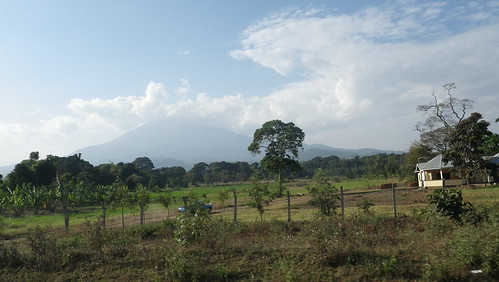
The above is Mount Meru, the sister mountain to Kilimanjaro, which is only 15,000 feet tall, or over 4,000 feet less than Kilimanjaro. As I have noted in my previous posts, I do not recommend climbing Kilimanjaro. However, I absolutely do recommend climbing Meru, for several reasons.
- It is also a non-technical climb.
- It can be done in three days - four if you are being extra careful for acclimatizing purposes.
- You sleep in cabins.
- It is way less crowded than Kilimanjaro.
- It is prettier, as there is vegetation almost the entire way to the summit.
- It is cheaper.
- There are a lot of animals - so many, in fact, that an armed guard is with you for the first and last quarters of the journey to make sure you aren't eaten. Coooooooool.
- You get awesome views of Kilimanjaro.
So, if you take away nothing else from this blog, it is this:
- DON'T climb Kilimanjaro.
- DO go on safari.
- DO climb Mt. Meru.
The above is the video of the Tanzanian countryside. As you can see, there are plenty of building interspersed, whether they be nomadic huts for the Maasai, permanent moisture farms, but also a surprising number of abandoned buildings. You'd think people would use every building they could get, but you would be wrong.

Above is a picture of the local market. The busiest days are Tuesdays and Sundays. See my previous post concerning the crafts market, which is very different from the above, which is more of a food and everyday item market.

Above is a picture of a roundabout that all the highways ran into - one each in Arusha and Moshi. They are monuments to some soldier. David told us which ones, but I forget now. One area we drove through, that David was particularly proud of, was the foreigner district. It's where most of the "nice" hotels, something resembling department stores, and NGOs were. At best, it looked like rundown parts of Harlem or West Philadelphia, but more white people, no building taller then three stories, and less hip hop music. David kind of excitedly asked us if this what it looked like where we lived. Didn't have the heart to tell him the truth, so "yes David, this is exactly what it looks like back home."
Another place David was particularly proud of was the western supermarket in the middle of town. He took us there on our first day to buy some snacks, although in hindsight, they fed us so much I literally don't think we touched any of the food until the last day at the airport. The inside had all the aisles a supermarket has, and they were relatively well stocked, but it was housed in a lowlit, dingy warehouse. It was clean, but eerie for several reasons. First, it was protected by a wall and an armed guard. In fact, just to get into the parking lot, you had to go through a checkpoint. Tons of regular Tanzanians would walk by and look in at us. Creepy. Second, the store itself was relatively empty of people. Maybe it was just when we went, but the only people there besides the workers (and yet more armed guards), was a white lady shopping with her servant, and an elderly African woman also shopping with her servant. Third, it was almost all prepared food, with a really, really small produce section. Which I guess makes sense, considering most of that stuff you could just get at the regular market for non-inflated prices. Nevertheless, we bought two shopping bags worth of chips, cookies, candy, and drinks, and paid just under 20 dollars.
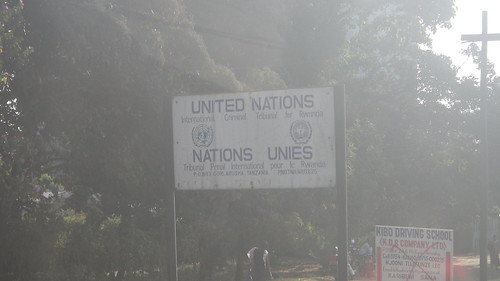
I found this kind of crazy. The United Nations International Criminal Tribunal Court for Rwanda is located here in Arusha. It was located in a guarded and walled compound in the "nice" part of town. I guess it is both a testament to Tanzania that it is stable enough to house this, and sad that Rwanda, and the ridiculous tragedy that occurred, happened so close to here.
The above video is of the Arushan "suburbs." As you can see, there are trees and fields intermixed with buildings.
The transition from suburb to city is subtle in that the only thing that really changes is that there are no more fields; just low level buildings. And we ARE in the downtown. Tall buildings never really take hold.
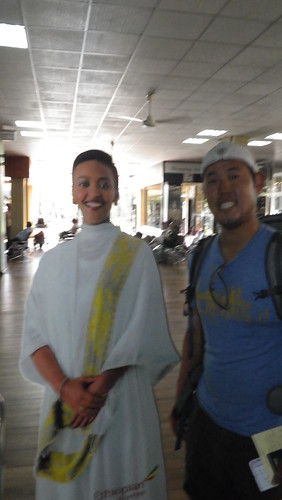
So anyways, back to the airport. Here I am with a pretty lifelike cutout of an Ethiopian Airlines stewardess. The Ethiopians we saw were actually a very good looking people, so the cutout is surprisingly not that much of an exaggeration.
Getting into the airport was quite an endeavor in itself. We went through three armed gates, a holding area where we were given then the third degree concerning what we were doing in Africa, where we were going, what we had bought, etc. The whole time they made it seem like we were trying to pull a fast one on them and unauthorizedly leave the country, and I was thinking "dude, do we really look like we are from here?" but I digress.
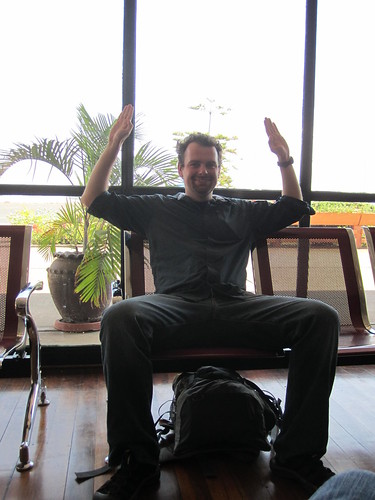
William, and one last Cornholio in Africa.
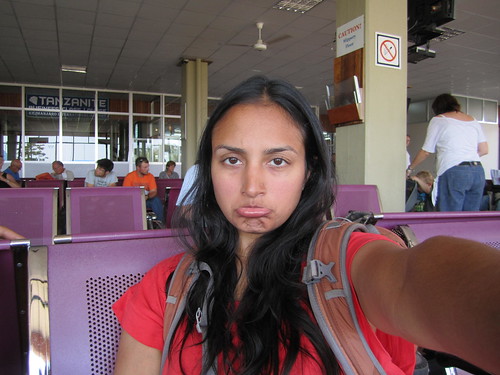
Resha, sad to be leaving. The liquor store/souvenir shop here was run by a bunch of South Asians, which I guess served as a sort of transition to Dubai.
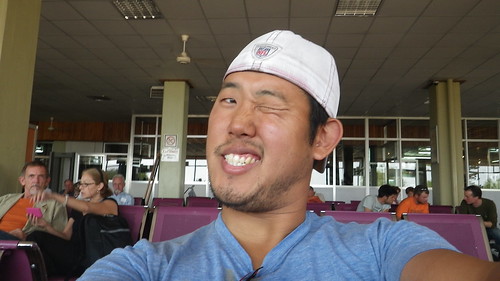
Me, both happy and sad to be leaving. And scruffy. VERY scruffy.
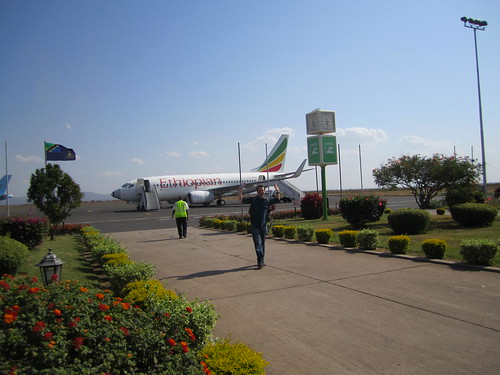
Okay, I lied. THIS is his last Cornholio.

And finally boarding the plane.
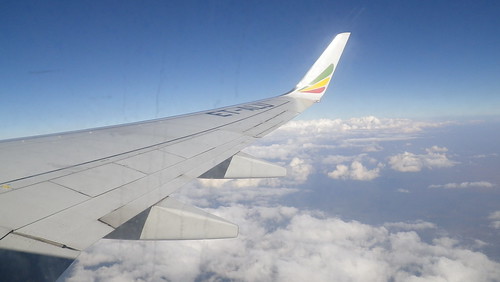
Tanzania, Africa, we hardly knew ya.
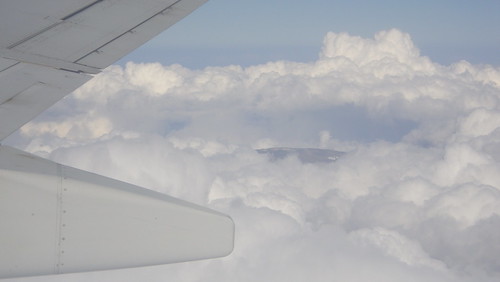
One last peak at Kibo (pun intended)...
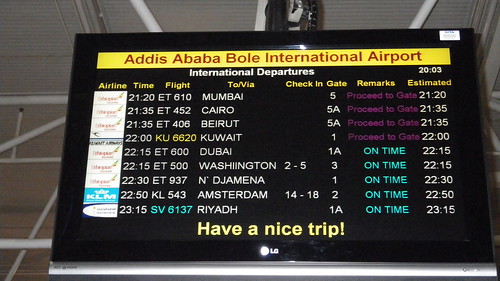
... and then to Addis Ababa before on to DUBAI! Stay tuned...
No comments:
Post a Comment